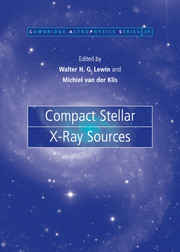Book contents
- Frontmatter
- Contents
- List of contributors
- Preface
- 1 Accreting neutron stars and black holes: a decade of discoveries
- 2 Rapid X-ray variability
- 3 New views of thermonuclear bursts
- 4 Black hole binaries
- 5 Optical, ultraviolet and infrared observations of X-ray binaries
- 6 Fast X-ray transients and X-ray flashes
- 7 Isolated neutron stars
- 8 Globular cluster X-ray sources
- 9 Jets from X-ray binaries
- 10 X-rays from cataclysmic variables
- 11 Super-soft sources
- 12 Compact steller X-ray sources in normal galaxies
- 13 Accretion in compact binaries
- 14 Soft gamma repeaters and anomalous X-ray pulsars: magnetar candidates
- 15 Cosmic gamma-ray bursts, their afterglows, and their host galaxies
- 16 Formation and evolution of compact stellar X-ray sources
- Author index
- Subject index
15 - Cosmic gamma-ray bursts, their afterglows, and their host galaxies
Published online by Cambridge University Press: 01 September 2009
- Frontmatter
- Contents
- List of contributors
- Preface
- 1 Accreting neutron stars and black holes: a decade of discoveries
- 2 Rapid X-ray variability
- 3 New views of thermonuclear bursts
- 4 Black hole binaries
- 5 Optical, ultraviolet and infrared observations of X-ray binaries
- 6 Fast X-ray transients and X-ray flashes
- 7 Isolated neutron stars
- 8 Globular cluster X-ray sources
- 9 Jets from X-ray binaries
- 10 X-rays from cataclysmic variables
- 11 Super-soft sources
- 12 Compact steller X-ray sources in normal galaxies
- 13 Accretion in compact binaries
- 14 Soft gamma repeaters and anomalous X-ray pulsars: magnetar candidates
- 15 Cosmic gamma-ray bursts, their afterglows, and their host galaxies
- 16 Formation and evolution of compact stellar X-ray sources
- Author index
- Subject index
Summary
Introduction
Regarded as an astrophysical mystery and a curiosity for decades, cosmic gammaray bursts are finally entering the mainstream of astronomy and astrophysics. In the past few years, we have learned that they lie at cosmological distances, and are probably caused, possibly among other things, by the collapses and subsequent explosions of massive stars. Energetically they are roughly analogous to supernovae, to which they may indeed be related in some cases; no new physics needs to be invented to explain their prodigious luminosities. Unlike supernovae, however, they are relatively rare, and their energy output is distributed quite differently over wavelength and time. They can probably be observed out to distances comparable to, or even farther than, those of the most distant quasars, which makes them useful to cosmologists as lighthouses to the early Universe. Finally, too, they hold the promise of revealing properties of early galaxies such as star formation rates and metallicities in ways that are unique. For all of these reasons, in addition to the facts that they signal the formation of black holes and drive ultra-relativistic winds, they have begun to attract the attention of people working in very diverse disciplines. The words “gamma-ray burst” have even begun to enter the vocabulary of the general public, which regards them with a certain morbid fascination.
It was not at all clear a decade ago that the study of gamma-ray bursts (GRBs) had such a promising future.
- Type
- Chapter
- Information
- Compact Stellar X-ray Sources , pp. 587 - 622Publisher: Cambridge University PressPrint publication year: 2006
- 3
- Cited by

